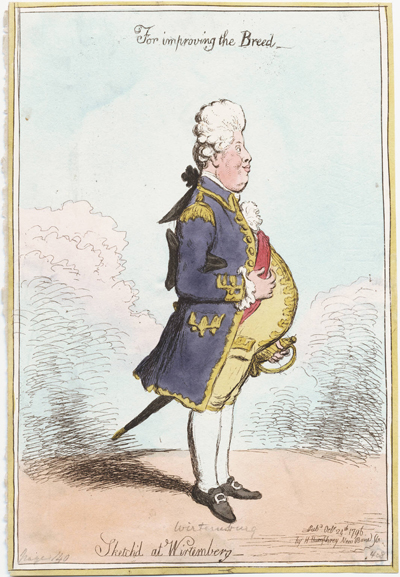For Improving the Breed
There are two portrait caricatures of Prince Frederick of Wurtemberg with the same title and publication date. The most obvious difference is the belly of the Prince, which has been considerably enlarged in the second version.

© Lewis Walpole Library, Yale University

© Lewis Walpole Library, Yale University
Both appear to have been quickly sketched, and it is likely that the second version was based on the first by simply burnishing away some lines, but mostly by adding lines to the existing plate. Note, for instance, how the belly line of the first version has become the sash or ribbon of the second, and the enlarged belly simply sketched in with new lines. The right calf has been thickened by the addition of shadowing on the back of the leg. And the background has been darkened and the shadow of the prince enlarged by adding more lines to those already there.
The impetus for the print was most likely the engagement of the hereditary Prince of Wurtemberg to the eldest daughter of the British Royal Family, Charlotte Augusta, or the Princess Royal as she was commonly known. The marriage had been under discussion since December of 1775 when Frederick wrote to King George proposing the union. But it was not until June of 1796 that George finally agreed to the proposal. And it was not announced officially until the fall of 1796. Wurtemberg was a poor state, surrounded by bigger, richer, and hostile principalities, so, in suggesting an alliance with the British crown, the Prince was certainly trying to improve his national profile if not the national breed itself.
In its September 14th edition, the London Star provided some background information about the person and lineage of the Prince, noting that:
The Herditary Prince is the eldest son of the reigning Duke of Wirtemberg. . . . He [previously] married an elder sister of our Princess of Wales, who died in Russia on the 27th of September 1788. He is corpulent but handsome in his person, and extremely active. . . His mother is neice to the last King of Prussia.
If the original portrait of the Prince was sketched at Wirtemberg, it was not by Gillray, and it is unlikely that Gillray knew or cared to know much about the Prince beyond his great belly. In fact, the Prince was not simply "corpulent." At 6 foot 11 inches and 440 pounds, he was a giant for his time. But in none of the Gillray prints in which the herditary prince appears is his unusual height suggested.
The title of the print, however, directs our attention to the important detail that remains fundmentally the same in both versions—the strategically placed and obviously phallic hilt of the Prince's sword. And indeed that part of the Prince's portrait seems well prepared to perform the responsibilities mentioned in the title.
Sources and Reading
- Commentary from the British Museum on For Improving the Breed
- "Frederick I of Wurtemberg," Wikipedia
- "Charlotte, Princess Royal," Wikipedia
- Janice Hadlow, A Royal Experiment, 2014, pp. 464 - 472.
- Thomas Wright and R.H. Evans, Historical and Descriptive Account of the Caricatures of James Gillray #408.
Comments & Corrections
NOTE: Comments and/or corrections are always appreciated. To make that easier, I have included a form below that you can use. I promise never to share any of the info provided without your express permission.